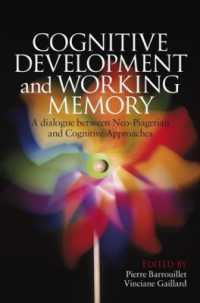Full Description
This reader explores the nature of interactions between children and their teachers in the classroom. It emphasises the importance of such relationships for children's learning and for educational practice.
Part 1 looks at different cultural conceptions of the teacher-learner relationship, and how this relates to schooling, cognitive development and the aquisition of knowledge.
Part 2 takes a closer look at the role of language and dialogue in interactions between adults and children in classrooms.
Part 3 describes research by developmental psychologists on peer interaction and collaborative learning, and discusses how it has advanced our understanding of how children learn from each other.
Part 4 considers the implications of classroom-based collaborative learning initiatives and the potential for creating 'communities of enquiry' which change how we think about knowledge acquisition.
Contents
Introduction Part 1: Cultural Psychology: a framework for understanding teaching and learning 1.L.S. Vygotsky and Contemporary Developmental Psychology James Wertsch and Peeter Tulviste 2.Cognitive Development and Formal Schooling: the evidence from cross-cultural research Michael Cole 3.Thinking With and Through Artifacts: the role of psychological tools and physical artifacts in human learning and cognition Roger Saljo 4.Thinking in Niches: sociocultural influences on cognitive development Mary Gauvain Part II: Teaching and Learning: scaffolding and the zone of proximal development 5.A Theory of Teaching as Assisted Performance Roger Tharoa and Ronald Galiimore 6.How Do Teachers Help Children to Learn? An Analysis of Teachers' Interventions in Computer-based Activities Neil Merver and Eunice Fisher 7,Vygotsky in Classroom Practice: moving from individual transmission to social transaction Luis C. Moll and Kathryn F. Whitmore 8.What is Missing in the Metaphor of Scaffolding? C.Addison Stone Part III: Experimental Studies of Collaborative Learning and Peer Interaction 9.Cognitive approaches to Group Work Paul Light and Karen Littleton 10.Exploring Vygotskian Perspectives in Education: the cognitive value of peer interaction Ellice A. Forman and Courtney B. Cazden 11.Peer Interactive Minds: developmental, theoretical and methodological Issues Margarita Azmitia Part IV: Collaborative Learning and Peer Interaction in the Classroom 12.Sociocultural Processes of Creative Planning in Children's Playcrafting Jacquelyn Baker-Sennett, Eugene Matusov and Barbara Rogoff 13.Constructing Scientific Knowledge in the Classroom Rosalind Driver, Hilary Asoko, John Leach, Educardo Mortimer and Philip Scott 14.Sharing Cognition Through Collective Comprehension Activity Giyoo Hatano and Kayoko Inagaki 15.Learning and Teaching Mathematics in the Information Era Kathryn Crawford








